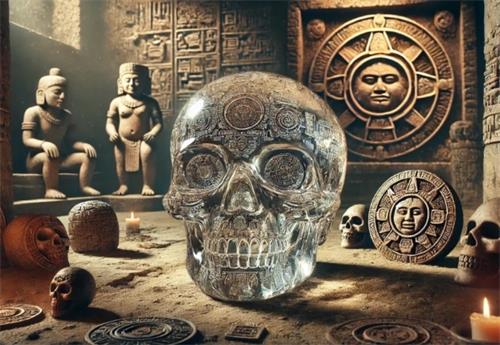
The crystal skulls, regarded as one of the most mysterious archaeological relics in the world, have long captivated people's attention. Many recognize them from the movie Indiana Jones and the Kingdom of the Crystal Skull, where they are depicted as artifacts of extraterrestrial origin, supposedly created by aliens who influenced ancient human civilizations. However, in the field of real-world archaeology, experts have not confirmed any extraterrestrial connection. To this day, 13 enigmatic crystal skulls remain unexplained, most of them found in Mesoamerican regions such as Honduras and Mexico. These skulls are often associated with the mystical Maya civilization and pyramids, leaving behind a trail of unanswered questions.
The most striking feature of these crystal skulls is that they are crafted from high-purity transparent crystal, with a smooth surface that lacks visible tool marks. Even more astonishing, their creation did not take into account the natural axis of the crystal, a feat that remains highly challenging even with modern technology. The craftsmanship of the crystal skulls is astonishing, especially in the intricate details and the special treatment of the crystal material. There are even claims that when a laser is directed into the skull's nasal cavity, it emits a glowing effect—an optical phenomenon attributed to the prismatic properties of crystal.
In 2008, a research team comprising British and American scientists conducted detailed examinations of crystal skulls housed in the British Museum and the Smithsonian Institution. Using electron microscopy and X-ray crystallography, researchers analyzed the surfaces of these skulls. The results revealed minute rotational scratches around the eye sockets, teeth, and cranial regions, indicating that they were shaped using a jewelry-making tool known as a "rotary wheel."
However, such technology did not exist during the time of the ancient Maya or even in pre-Columbian America. As a result, researchers speculate that these crystal skulls were most likely crafted in Europe, with the material sourced from colorless Brazilian quartz. Scientists believe that after their creation, the skulls may have entered the market as mysterious relics, eventually becoming prized possessions of private collectors through the hands of the Maya or Aztecs.
As research progresses, many museums have removed crystal skulls from display, questioning their origins and historical significance. Many experts argue that these skulls lack true archaeological value and instead represent an unresolved historical mystery.
Among these enigmatic crystal skulls, the most famous is the so-called "Doomsday Skull." In 1924, this skull came into the possession of Anna Mitchell-Hedges, who inherited it from her adoptive father, British explorer F.A. Mitchell-Hedges. Anna claimed that the skull dates back 3,600 years and, under specific lighting conditions, its eye sockets emit a blue glow. More astonishingly, she alleged that when placed near a computer, the skull could cause hard drive failures. However, no scientific tests have ever been conducted on this skull, as its current owner has not permitted any examinations—further deepening its air of mystery.
In general, there is no conclusive evidence about the origin of the crystal skull, and the scientific community still has great differences on its research. Their manufacturing process, historical background, and mysterious features all give people deep insight into the understanding of ancient civilizations. Whether a relic of an alien civilization or a masterpiece of an ancient craftsman, the crystal skull remains one of the most controversial and fascinating mysteries of archaeology and folklore.

The Mysterious Face of Mars
The Mysterious Face of Mars: Natural Formation or Remnant of an Alien Civilization?
The "Face on Mars" is a peculiar landform in the Cydonia region of Mars that has long captured the attention of scientists and astronomers.

Adonis,Venus
Love Ruled by Fate: The Wheel of Destiny of Adonis and Venus
In the vast ocean of art, some paintings transcend time and space, carrying intense emotions and profound stories. Titian's Venus and Adonis is one such masterpiece, depicting a beautiful yet tragic love story.

Pyramid
Unveiling the Mystery of Pyramid Construction: How Massive Stones Were Transported
Deep within the western Sahara Desert of Egypt, a long-buried ancient tributary of the Nile may hold the key to solving the mystery of how the Egyptian pyramids were built.


